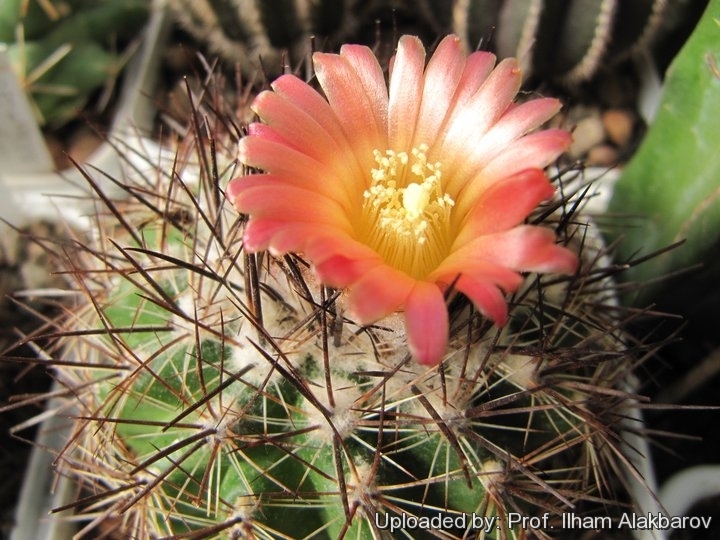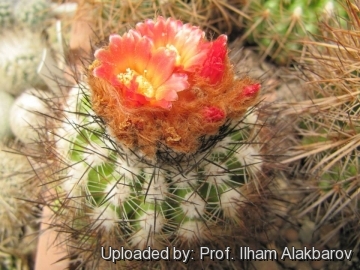Accepted Scientific Name: Parodia comarapana Cárdenas
Revista Agric. (Cochabamba) 7(6): 24 (fig.). 1951

Parodia mairanana var. atra Photo by: Prof. Ilham Alakbarov
Origin and Habitat: Mairana, Florida, Santa Cruz, Bolivia
Altitude range: 1200-1600(-1800) metres above sea level.
Habitat end ecology: Parodia mairananaSN|5768]]SN|5775]] v. atra grows together with Parodia columnarisSN|5775]]SN|5768]].
Synonyms:
See all synonyms of Parodia comarapana
back
Accepted name in llifle Database:Parodia comarapana CárdenasRevista Agric. (Cochabamba) 7(6): 24 (fig.). 1951Synonymy: 7
back
Description: Parodia mairanana var. atraSN|29906]]SN|29906]] is a small free-flowering cactus that also has orange, brick-red or rusty-red blossom, but differs from Parodia mairananaSN|5771]]SN|5775]] in having shiny dark green body with very dark spines, almost black especially in young areoles, later lighter, the central one more or less bent or hooked. The pericarpel (flower's tube) is covered in dark-red hairs.
Remarks: Parodia mairananaSN|5771]]SN|5775]] is considered currently a synonym of Parodia comarapanaSN|5775]]SN|5771]] and are normally assessed together. However some authors suggest to separate them as two different species. Parodia comarapanaSN|5775]]SN|5771]], as most Parodias, is very variable and many morphological forms has received varietal names of controversial botanical value: Parodia mairanana var. atraSN|29906]]SN|29906]] is one of them.
Habit: It is a small usually solitary or slowly offsetting around its base.
Stem: Small, greyish-green to dull green, attaining about 8 cm in diameter and 4,5 cm in height.
Ribs: About 15 -16 (or more), forming small tubercles.
Areoles: Young areoles are relatively large, and filled with abundant white wool. Later they are naked.
Radial spines: 9-15 or so, thin, whitish grey or yellow with a brownish tip, more or less curved (which is a useful recognition factor)
Central spines: 3 or 4, very similar to the radials. One of the centrals appears longer than all others, and and may occasionally be more or less hooked and dark-gray, brown or almost black, in var. atra.
Flowers: Small, funnel-shaped, apical, mostly orange tinged with red or rusty-red (but ranging in color from yellow through pink to scarlet) 2-3.5 cm wide. Dried flowers remain for a long time on the plant body after blooming.
Blooming season: Spring to summer, but with favorable conditions this one blooms almost all year, just taking "catnaps" in-between.
Fruit: Red or green, with white hairs (dark red in var. atra).
Subspecies, varieties, forms and cultivars of plants belonging to the Parodia comarapana group
- Parodia comarapana Cárdenas: flowers mostly orange tinged with red or rusty-red, but also yellow or pink. Distribution: Santa Cruz and Florida in the north of Comarapa, Bolivia.
 Parodia mairanana Cárdenas: has flowers in various combinations of orange,brick red and dull vermilion. Distribution: Above Agua Clara in the neighbourhood of Mairana.
Parodia mairanana Cárdenas: has flowers in various combinations of orange,brick red and dull vermilion. Distribution: Above Agua Clara in the neighbourhood of Mairana.  Parodia mairanana var. atra Backeb.: has dark green body with dark spines, almost black in young areoles. The pericarpel is covered in dark-red hairs. Distribution: Mairana, Florida, Santa Cruz, Bolivia
Parodia mairanana var. atra Backeb.: has dark green body with dark spines, almost black in young areoles. The pericarpel is covered in dark-red hairs. Distribution: Mairana, Florida, Santa Cruz, Bolivia - Parodia neglecta F.H.Brandt
- Parodia neglectoides F.H.Brandt
Bibliography: Major references and further lectures
1) Backeberg C., "Die Cactaceae", 3 : 1601, 1959
2) Backeberg C., "Das Kakteenlexikon", p. 345, 1966
3) Brandt F.H., Kakt. und Orch.-Rundschau, 7 : 56, 1982
4) Buining A.F.H., Succulenta, 44 : 102-103, 1965
5) Jelínek J., Kaktusy 80, 16 : 65, 1980
6) Königs G., Kakt. und and. Sukk., 12 : 23, 1961
7) Königs G., Succulenta, 40 : 31, 1961
8) Krahn W., Internationaal tijdschrift voor succulentenliefhebbers, 2 : 50, 1968
9) Krainz H., "Die Kakteen", 1.3.1969
10) Lau A.B., Cact. Succ. J. (US), 54 : 125, 1982
11) Verheulpen W., Cactus, Antwerpen, p. 116-118, 1981
12) Weskamp W., "Die Gattung Parodia", p. 208-209, 1987
 Parodia mairanana var. atra Photo by: Prof. Ilham Alakbarov
Parodia mairanana var. atra Photo by: Prof. Ilham AlakbarovSend a photo of this plant.The gallery now contains thousands of pictures, however it is possible to do even more. We are, of course, seeking photos of species not yet shown in the gallery but not only that, we are also looking for better pictures than those already present.
Read More... Cultivation and Propagation: Water these plants regularly, and fertilize with a low nitrogen fertilizer every 6 to 8 weeks, from mid-spring to late summer. This plant should remain rather dry at other times (especially in winter), except for a quick, periodic misting on warmer days in late winter. If it is kept absolutely dry for a long period, it tends to lose its roots in winter. It can tolerate light frost (- 4C°), but rots easily if wet and cold.
If the local climate is warm enough to grow this plant outside, be sure that soil is well drained and sun if full, but with protection from strong midday rays.
Propagation: By Seeds that are very fine. Patience is required when growing various Parodia species from their small, slowly germinating seeds, some of which take as many as two years to germinate.











